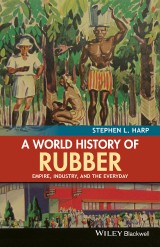Details
A World History of Rubber
Empire, Industry, and the Everyday1. Aufl.
|
20,99 € |
|
| Verlag: | Wiley-Blackwell |
| Format: | EPUB |
| Veröffentl.: | 28.09.2015 |
| ISBN/EAN: | 9781118934258 |
| Sprache: | englisch |
| Anzahl Seiten: | 192 |
DRM-geschütztes eBook, Sie benötigen z.B. Adobe Digital Editions und eine Adobe ID zum Lesen.
Beschreibungen
<p><i>A World History of Rubber</i> helps readers understand and gain new insights into the social and cultural contexts of global production and consumption, from the nineteenth century to today, through the fascinating story of one commodity.</p> <ul> <li>Divides the coverage into themes of race, migration, and labor; gender on plantations and in factories; demand and everyday consumption; World Wars and nationalism; and resistance and independence</li> <li>Highlights the interrelatedness of our world long before the age of globalization and the global social inequalities that persist today</li> <li>Discusses key concepts of the nineteenth and twentieth centuries, including imperialism, industrialization, racism, and inequality, through the lens of rubber</li> <li>Provides an engaging and accessible narrative for all levels that is filled with archival research, illustrations, and maps</li> </ul>
<p>Acknowledgments ix</p> <p>Timeline xi</p> <p>Global Rubber and Tire Companies xvii</p> <p><b>Introduction: Why Rubber? 1</b></p> <p>Global Connections 8</p> <p><b>1 Race, Migration, and Labor 10</b></p> <p>“Wild Rubber” and Early Industry 11</p> <p>“Wild Rubber” and Empire 14</p> <p>Plantations’ Progress: “Rationality and Efficiency” 17</p> <p>Plantation Hierarchies 21</p> <p>Race and Industry in the United States and Europe 29</p> <p><b>2 Women and Gender on Plantations and in Factories 40</b></p> <p>Gendering the Jungle and the Plantation 42</p> <p>Asian Women on Plantations 44</p> <p>European Women and Racism 48</p> <p>The Colonizing Woman 50</p> <p>Gendered Production in the United States and Europe 52</p> <p>Rubber and Sex in Indochine 56</p> <p><b>3 Demand and Everyday Consumption 61</b></p> <p>Everyday Consumption on Southeast Asian Plantations 62</p> <p>Class and Consumption in North America and Europe 64</p> <p>Race and Consumption in Europe and North America 68</p> <p>Gender and Consumption in Europe and North America 71</p> <p>Gendering Reproduction 77</p> <p><b>4 World Wars, Nationalism, and Imperialism 83</b></p> <p>World War I 84</p> <p>“See America First” on “Good Roads” 86</p> <p>Flying for the Nation 88</p> <p>Restricting Rubber in the Wake of War 90</p> <p>American Assertions: Herbert Hoover and US Trade 91</p> <p>Firestone and Friends 94</p> <p>Firestone in Liberia 96</p> <p>Germany: Colonies and Chemicals 99</p> <p>World War II and the US Scramble for Rubber 102</p> <p>Nazi Racism and Buna at Auschwitz 105</p> <p>Imperialism and Nationalism in the Wake of World War II 107</p> <p><b>5 Resistance and Independence 111</b></p> <p>Plantations and Resistance 112</p> <p>Global Economic Crisis and Plantation Labor 118</p> <p>Success of the Smallholders 120</p> <p>Plantations under the Japanese 124</p> <p>Independence and Decolonization 126</p> <p>United Rubber Workers 131</p> <p>Conclusion: Forgetting and Remembering Rubber 137</p> <p>Suggested Readings 142</p> <p>Index 157</p>
<p><b>Stephen L. Harp</b> is Professor of History, Professor of French, and Director of Humanities at the University of Akron, USA. He is a social and cultural historian focused on transnational European and world history. He is the author of <i>Au Naturel: Naturism, Nudism, and European Tourism in Twentieth-Century France</i> (2014), <i>Marketing Michelin: Advertising and Cultural Identity in Twentieth-Century France</i> (2001), and<i> Learning to Be Loyal: Primary Schooling as Nation Building in Alsace and Lorraine, 1850-1940</i> (1998). He resides in Akron, Ohio, the former global “rubber capital.”</p>
<p><i>A World History of Rubber</i> helps readers understand and form new insights into the social and cultural contexts of global production and consumption from the nineteenth century to the present. Stephen Harp uses rubber as a lens through which readers can view many key themes and events of the nineteenth and twentieth centuries, including imperialism, industrialization, racism, and inequality.</p> <p>The book illuminates the complex journey of rubber from plantations in far-flung European colonies, to factories in Midwest America, to products in American homes and abroad. It is divided into five thematic sections: race, migration, and labor; gender on plantations and in factories; demand and everyday consumption; World Wars and nationalism; and resistance and independence. The story highlights the interrelatedness of our world long before the current era of globalization, as well as the global social inequalities that persist today. With an engaging and accessible narrative that will resonate with students of all levels as well as general readers, this account of a single commodity skillfully ties together the history of many people, places, and ideas the whole world over.</p>



















